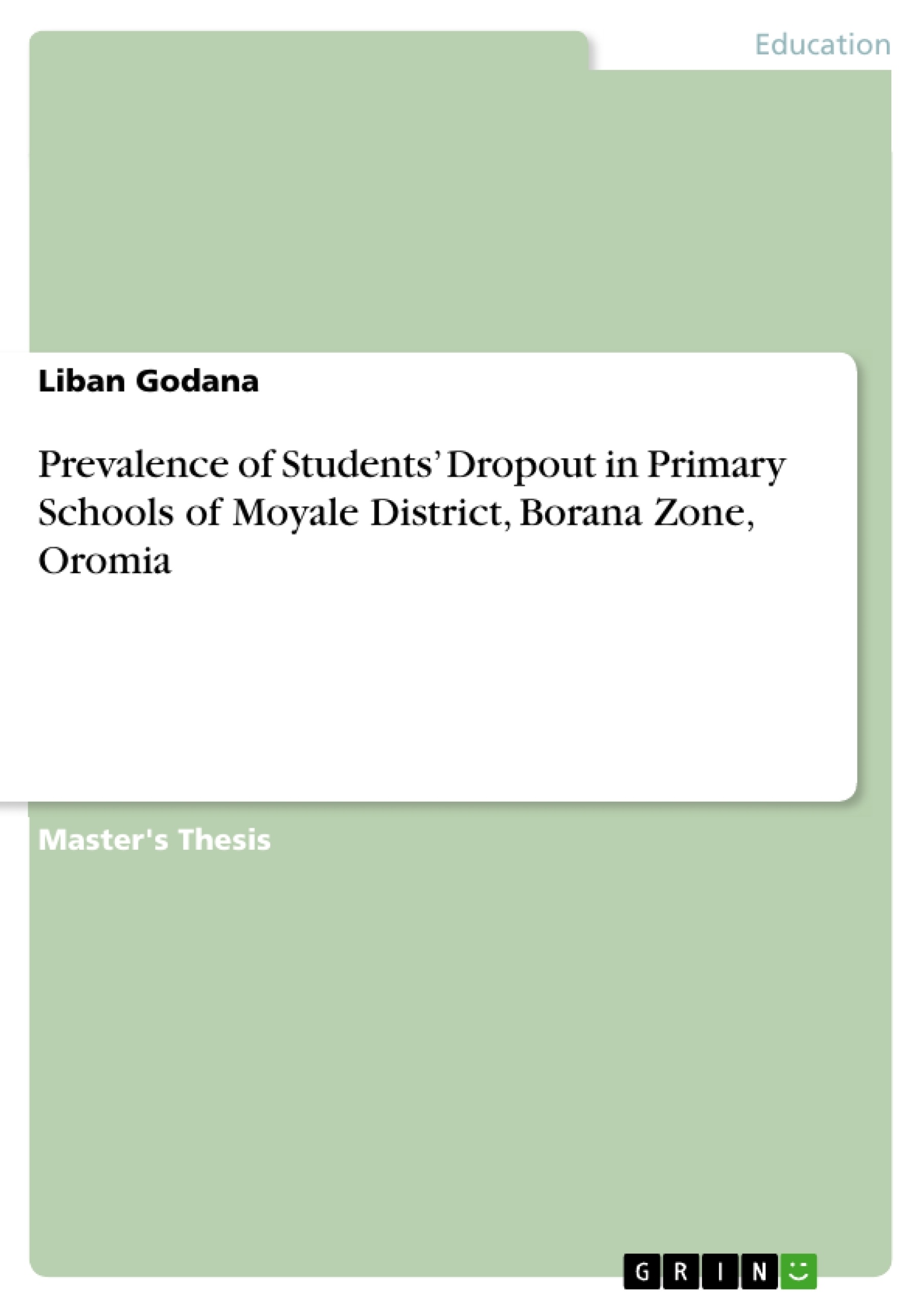The objective of this study was to investigate the prevalence of students’ dropout in Primary schools of Moyale District, Borana Zone, Oromia. Pragmatism as a philosophical assumption was employed. In this study, mixed research method and concurrent triangulation design was used. Both primary and secondary data were gathered using questionnaires, interviews, document analysis, focus group discussion, validity and reliability were used to test the tools’ quality.
Again, probability (simple random and systematic, sampling technique), and non-probability (purposive and availability) sampling techniques were employed. To attain the objective of the study, 12 primary schools, were selected out of 36 government primary schools in the district using purposive sampling, because they are fully primary.
Inhaltsverzeichnis (Table of Contents)
- ACKNOWLEDGEMENTS
- Table of content
- LIST OF TABLES
- LIST OF FIGURES
- ABBREVIATIONS AND ACRONYMS
- ABSTRACT
- CHAPTER ONE
- INTRODUCTION
- Background of the study
- Statement of the problem
- Objectives of the study
- General objective
- Specific objectives
- Research questions
- Significance of the study
- Delimitation of the study
- Limitation of the study
- Operational definition of key terms
- Organization of the study
- CHAPTER TWO
- REVIEW OF RELATED LITERATURE
- Nature and concepts of educational efficiency
- Repetition
- Dropout
- Factors associated with students' drop out
- Student and family factors
- School factors
- Outside factors
- Impacts of students' drop out
- Theoretical and conceptual framework of the study
- Theoretical framework of the Study
- General Deviance theory
- Deviant Affiliation theory
- Poor Family Socialization theory
- Structural Strains theory
- Theory of Institutional Departure
- Academic Mediation theory
- Conceptual Framework of the study
- Theoretical framework of the Study
- CHAPTER THREE
- RESEARCH METHOD AND DESIGN OF THE STUDY
- Description of the study area
- Sources of Data
- Population of the study
- Samples and Sampling Techniques
- Data collection instruments
- Questionnaire-Survey
- Interview
- Documents analysis
- Focus group discussion
- Data gathering procedures
- Research validity and reliability
- Validity
- Reliability
- Methods of data analysis
- Ethical consideration
- CHAPTER FOUR
- DATA PRESENTATION, ANALYSIS, AND INTERPRETATION
- Characteristics of respondents
- Prevalence of students' dropout
- Factors contributing students' drop out
- Family and students related drop out contributing factors
- School related factors contributing students' drop out
- School related students' drop out contributing factors
- Outside factors contributing students' drop out factors
- Impacts behind the prevalence of students' drop out
- Drop out impacts on personal level
- Drop out impacts on society level
- Drop out impacts on countrywide level
- CHAPTER FIVE
- SUMMARY, CONCLUSION AND RECOMMENDATIONS
- SUMMARY OF THE RESEARCH STUDY
Zielsetzung und Themenschwerpunkte (Objectives and Key Themes)
This study investigates the prevalence of student dropout in primary schools of Moyale District, Borana Zone, Oromia region, Ethiopia. The main objective is to assess the extent of student dropout and identify factors contributing to this phenomenon. The research aims to explore the impact of dropout on individuals, society, and the nation. Key themes and objectives of the study include:- Understanding the prevalence of student dropout in primary schools of Moyale District.
- Identifying the factors contributing to student dropout, including family, school, and outside factors.
- Analyzing the impact of student dropout on individuals, society, and the nation.
- Providing recommendations to address the problem of student dropout and enhance educational efficiency.
- Utilizing relevant theoretical frameworks such as General Deviance Theory, Deviant Affiliation Theory, Poor Family Socialization Theory, and Structural Strains Theory to interpret findings.
Zusammenfassung der Kapitel (Chapter Summaries)
- Chapter One introduces the study, highlighting the problem of student dropout in primary schools within Moyale District. It lays out the study's objectives, research questions, significance, delimitation, limitations, key term definitions, and the organizational structure.
- Chapter Two delves into the existing literature on educational efficiency, focusing on the concepts of repetition and dropout. It examines factors contributing to student dropout, including student and family factors, school factors, and outside factors. The chapter concludes by outlining the theoretical and conceptual framework underpinning the research, drawing on theories such as General Deviance Theory, Deviant Affiliation Theory, Poor Family Socialization Theory, and Structural Strains Theory.
- Chapter Three outlines the research methodology and design. It describes the study area, data sources, population, sampling techniques, and data collection instruments, including questionnaires, interviews, document analysis, and focus group discussions. It details the data gathering procedures and addresses the research validity and reliability, encompassing ethical considerations.
- Chapter Four presents, analyzes, and interprets the collected data. It begins by outlining the characteristics of respondents, followed by an examination of the prevalence of student dropout. The chapter then explores the factors contributing to student dropout, categorized by family and student factors, school factors, and outside factors. Finally, it analyzes the impacts of student dropout on individuals, society, and the nation.
Schlüsselwörter (Keywords)
The study focuses on the critical issues of student dropout, educational efficiency, primary education, factors contributing to dropout, and the impact of dropout on individuals, society, and the nation. Key terms relevant to the research include: student dropout, primary education, educational efficiency, family factors, school factors, outside factors, societal impact, national impact, General Deviance Theory, Deviant Affiliation Theory, Poor Family Socialization Theory, and Structural Strains Theory.- Quote paper
- Liban Godana (Author), 2020, Prevalence of Students’ Dropout in Primary Schools of Moyale District, Borana Zone, Oromia, Munich, GRIN Verlag, https://www.grin.com/document/1277012



